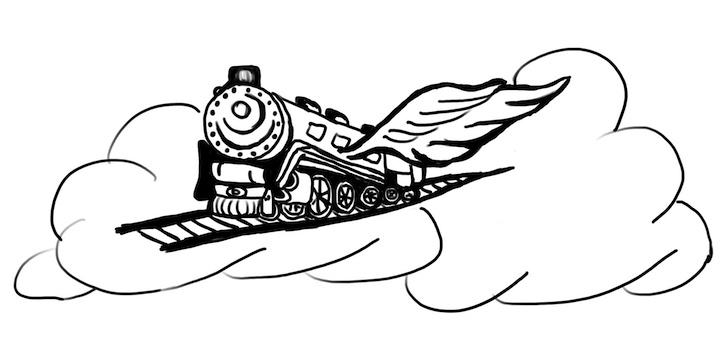Why the U.S. needs high-speed rail
September 22, 2023
 This
piece represents the opinion of the author
.
This
piece represents the opinion of the author
.
 Alondra Romero
Alondra RomeroThe United States has one of the worst passenger rail systems in the world. Excluding the Acela route, Amtrak trains are infrequent, expensive and more prone to delay than their European and East Asian counterparts. In rankings of high-speed rail network length, the United States falls in 11th, just behind Sweden, which has a population roughly the same size as North Carolina’s. For many Americans, it’s hard to imagine the quality of life improvements afforded by efficient passenger rail. Bumper to bumper traffic jams and long TSA lines are so ubiquitous that it’s hard to imagine an alternative. Nonetheless, many other countries have established rail networks that can smoothly take you to work five miles away or to a vacation 500 miles away, all while enjoying the view passing by your window. Of course, these are matters of personal preference, but I think it would be hard to find an American returning from traveling in Europe who doesn’t feel that our country has a failing transportation system.
Despite the dismal state of passenger rail today, the United States used to have a much more expansive and efficient network. In the mid 20th century, the automobile industry’s growing influence over government policy led to increased investment of public money in highways. In 2022, the Federal Highway Administration received $64.3 billion, while Amtrak got only $2.3 billion. Public spending on airports and airline deregulations in the 1970s struck another blow to passenger rail. During those same years, France invested heavily in developing record-fast high-speed trains that were able to beat air travel times on some of the country’s longest routes.
I make this comparison to show that our terrible rail network today is not the result of an inherent superiority of automobile and air travel that would have inevitably overshadowed rail; it was the result of government policy, which systematically prioritized the former over the latter, often at the behest of lobbying by the auto, aviation and fossil fuel industries. That’s why, even in the dreadful state that passenger rail is in, Republicans have proposed cutting Amtrak’s funding by 64 percent in next year’s federal budget.
Although Democrats played a similar role as Republicans in fostering the decay of U.S. passenger rail, the party has given it more attention under Joe Biden. The Bipartisan Infrastructure Law the President loves discussing invested an unprecedented $66 billion in U.S. rail transportation. This money will go towards providing the Northeast Corridor with faster trains, expanding service to new cities and improving safety throughout. Although that may sound like a lot, it’s only a small step in the right direction. For example, a high-speed rail network currently under construction in California connecting the state’s major cities will cost $128 billion to complete. Besides the money, there are deeper structural issues plaguing passenger rail that must be addressed.
If you’ve ever taken the train down to Boston, you probably didn’t realize that the rails you were traveling on are rented, not owned, by Amtrak. This distinction is important, since these rental contracts technically give Amtrak priority to use the rails, but in reality, freight train companies frequently violate the policy and give their own trains priority without consequence. The need to wait for slow, extremely long freight trains to pass remains one of the most common causes of Amtrak delays, especially in the South. Many upcoming projects, like California’s high-speed rail, will build their own track and avoid these delays. However, most Amtrak routes that serve less populous cities likely won’t get that same upgrade.
That’s why the simplest and most effective solution—one already implemented by countries like Germany, France and Italy—would be nationalizing the railroads. Public ownership would allow government operators to give passenger rail much needed priority status, and it could address issues in the freight train system, as well. In the United States, four companies control over 80 percent of the freight market. This arrangement has ensured record profits for shareholders and executives while railroad workers have dealt with understaffing, poor working conditions and zero paid sick leave days. In the hopes that it could break up corporate power and lead to greater profit sharing with employees, the Railroad Workers Union has called for nationalization, too.
Nationalization would only be the first step, after which the government should make substantial investments in an expanded national network. Besides creating jobs and stimulating economic growth, an expansion of this scale would be an important step towards Biden’s goal of net zero emissions by 2050. In fact, I believe that our government’s ability to improve its passenger rail system is a litmus test for whether it will undertake policy serious enough to avert the climate change disaster we are currently heading toward. Transportation makes up about 20 percent of emissions, the vast majority of which come from automobiles and airplanes. Rail travel, especially when electric, generates significantly fewer emissions.
Because of this, some mainland European countries have begun passing laws limiting short-haul commercial flights (30 minutes to 3 hours) while at the same time investing in high-speed and overnight rail services to replace them. My point here is not that a high-speed passenger rail network would solve global warming overnight. In reality, having Japanese-quality high-speed trains connecting all major American cities would reduce only a fraction of the emissions needed to curb climate change. However, at a time when many green energy solutions and battery technologies are still in development and have room to improve, expanding electric passenger rail is one of the most tested and reliable climate solutions we could begin implementing right now. It may be a small step, but since there’s a long road ahead of us, that’s all the more reason it needs to be taken soon.

Comments
Before submitting a comment, please review our comment policy. Some key points from the policy: